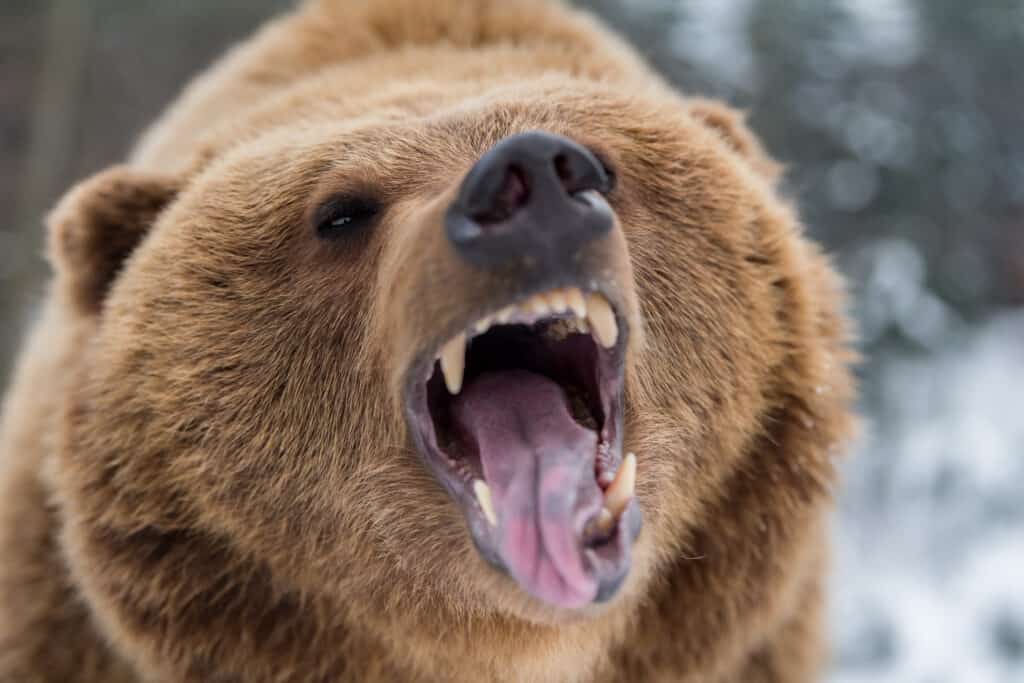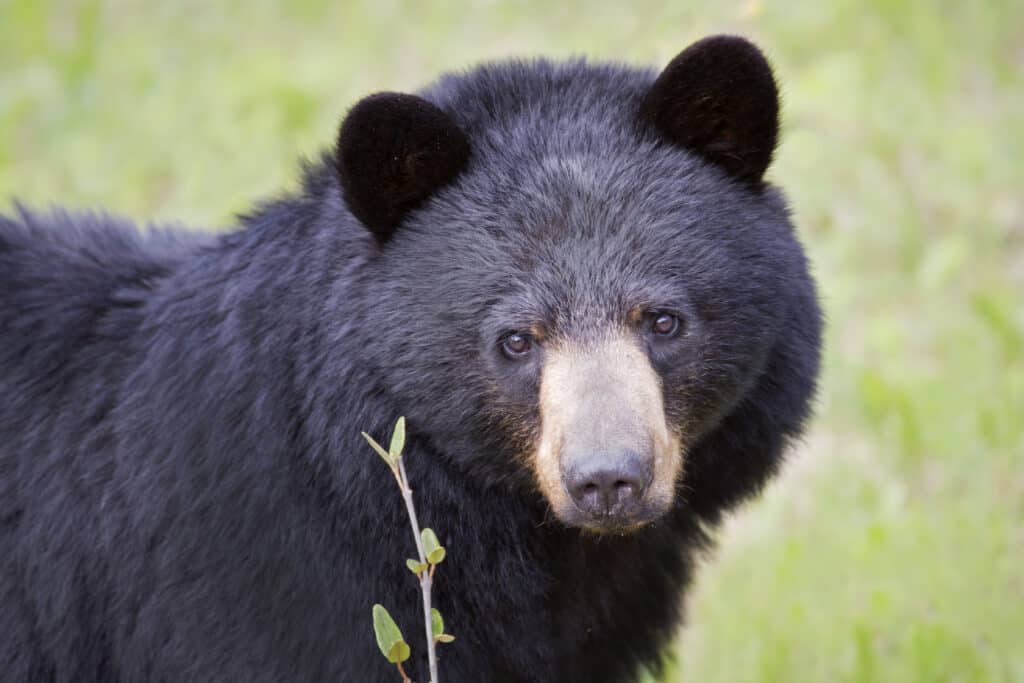One of the most geographically diverse states in the United States, Oregon is a land of majestic beauty. The state contains volcanos, dense evergreen and mixed forests, high deserts, and vast bodies of water. You can also find a wide range of plants and animals in the states, including bears. Today, only American black bears live in Oregon, but the state also used to possess a large number of grizzlies. Read on to discover the largest bear ever caught in Oregon!
The Largest Bear Ever Caught in Oregon

A grizzly bear was the largest bear ever caught in Oregon.
©Volodymyr Burdiak/Shutterstock.com
By bar, the largest bear ever caught in Oregon was a grizzly bear that went by the name Old Reelfoot. Also known as “Clubfoot,” this huge grizzly used to roam the land around the Southern Cascades and Siskiyou Crest in southern Oregon. In the late 19th century, settlers in the Pacific Northwest often came face-to-face with bears. These early settlers were homesteaders that farmed and raised livestock that attracted the attention of local bears. While many large bears lived in Oregon at the time, no bear filled settlers with more dread than Old Reelfoot. This giant grizzly spent decades roaming the countryside and would occasionally kill and eat livestock. According to some accounts, Old Reelfoot killed hundreds of cattle between the 1860s and 1890s. He possessed a lame front paw that caused him to leave characteristic skewed tracks, hence his name.
For years, cattle ranchers and hunters tried and failed to kill Old Reelfoot. At one point, several ranchers offered a reward of $2,700 to the person who could prove the killing of Old Reelfoot. One day in 1890, Old Reelfoot killed a prize bull owned by a homesteader named William Wright. Enraged, Wright set out with a group of five other hunters on April 5, 1890, eager to take down the infamous grizzly. After four days of tracking the bear, several of the hunters gave up, but Wright and one other hunter – Purl Bean – continued their pursuit.
Then, on April 10th, Wright and Bean, along with 2 dogs, discover Old Reelfoot at Wildcat Gulch near Pilot Rock, Oregon. The two men took aim at the bear and fired two shots, which both found the mark. However, the rifle shots only served to whip the bear into a frenzy, and he charged at the hunters. With the help of their dogs, Wright and Bean rained bullets down on the bear as he charged toward them up a ridge. Eventually, Old Reelfoot succumbed to his wounds and expired.
With Bean’s knife, the two men took measurements of Old Reelfoot. From nose to tail, he measured 7 feet long and stood nearly 9 feet high. His hind foot measured 16 inches, his head 18 inches, and his claws exceeded 5 inches. When news of Old Reelfoot’s death emerged, one paper – the Dalles Times-Mountaineer – claimed that he weighed 3,200 pounds. In reality, the bear weighed approximately 1892 pounds. Despite the exaggeration, his true weight still makes Old Reelfoot one of the heaviest recorded grizzlies in history.
Bears in Oregon: Types and Appearance
Old Reelfoot likely ranked as one of the last giant grizzly bears to live in Oregon. The last documented grizzly in Oregon was killed by a federal trapper on September 14, 1931. Although grizzlies no longer roam the Oregon countryside, you can still find American black bears in the state.
You can quickly tell apart black bears from grizzly bears due to their size, color, and shape. Black bears usually appear black or dark brown, hence their name. However, they can also appear grayish-blue, cinnamon, or blond. Meanwhile, grizzlies commonly feature a light or dark brown coat, but can also look reddish-blond or almost blond. The term “grizzled” refers to their hair, which can appear tipped with white. While black bears and grizzly bears can look similar in terms of color, they vary greatly in size and shape.
Adult black bears measure 3 to 5 feet long, with females typically measuring smaller than males. On average, female black bears weigh 90 to 300 pounds, while males weigh from 130 to 500 pounds. Conversely, grizzly bears measure 5 to 7 feet long and can stand up to 10 feet tall. They vary considerably in weight but normally range between 200 and 900 pounds. That means Old Reelfoot weighed nearly twice as much as the average grizzly! Additionally, grizzly bears possess a dished face profile, short and round ears, and a distinct shoulder hump. On the other hand, black bears have a straight face profile, tall and pointed ears, and no shoulder hump.
Bear Habitat in Oregon

Black bears prefer to live in densely forested areas in Oregon.
©Wild Art/Shutterstock.com
American black bears live throughout much of North America. Most black bears in the United States live in the northwest, northeast, and Great Lakes regions. That said, you can also find some black bears in the southeast and southwest. Most black bears in North America live in Canada, although you can also find a small population in parts of Mexico. Meanwhile, most grizzly bears in the United States live in western Montana. You can also find isolated populations in northeastern Idaho, northwestern Wyoming, and northwestern Washington. The bulk of the grizzly bear population in North America lives in western Canada and Alaska.
The bulk of black bears in Oregon range from the Cascade Range west to the Pacific Ocean and throughout the Blue and Wallowa mountains. They prefer to live in densely forested areas away from humans. Black bears like areas with lots of trees that they can climb and also use to make dens. While you can find them in Oregon’s wetlands, they avoid the semi-arid central regions of the state. Occasionally, black bears may wander into densely populated areas in search of food.
How Many Bears Are There in Oregon?
According to the Oregon Department of Fish and Wildlife, between 25,000 and 30,000 bears currently live in Oregon. Most bears in the state live around the Cascade, Coast, and Blue Mountains Ranges. Only black bears currently reside in Oregon. The grizzly bear population officially died out in 1931 with the death of the last grizzly bear in the state. Black bears in Oregon mostly live in dense forests but sometimes venture into human habitation. Although they are not as widespread as they used to be, the total North American black bear population exceeds 800,000. As a result, the American black is listed as a species of Least Concern by the IUCN.
Is It Legal to Hunt Bears in Oregon?
Prior to 1961, Oregon classified bears as predators. This meant that anyone could kill a bear without needing a permit. As a result, settlers wiped out all the grizzlies in the state in just under one hundred years. In 1961, the Oregon Department of Fish and Wildlife reclassified black bears as game animals. From that point on, the state set limits on the hunting of black bears. Today, Oregon sets designated hunting seasons, limits on tag sales, and maintains specific bear hunting areas. Unlike some states, you cannot use bear bait or dogs to hunt bears in Oregon. Oregon set these restrictions in place with the passage of Measure 18 in 1994. As a result, the number of hunting tags or permits dramatically increased. In 1994, 18,412 tags were sold, while in 2010, approximately 57,472 tags were sold.
Are Bears Dangerous?
Bears are wild animals and as such, can be extremely dangerous. Bears – particularly grizzly bears – possess incredible power. A black bear can uproot small tree stumps with ease, while a grizzly bear can break a full-grown moose’s back with a single blow. They have an excellent sense of smell but rather poor eyesight. Although they can pose a danger to humans, bears are notoriously skittish. A bear would much rather run away from a human than try to make one its next meal. Most confrontations between people and bears occur when a person gets between a bear and its food or a mother bear and her cubs. However, the longer that a bear lives in close proximity to humans, the greater the likelihood of a deadly encounter. Still, the likelihood of being attacked by a bear is about 1 in 2.1 million.
It’s important to stay calm when you encounter a wild bear. Maintain eye contact and don’t turn your back on the bear or try to run away. If you run away, the bear may mistake you for prey and take chase. If you encounter a grizzly, speak calmly and let the bear know where you are. Stand your ground if the bear charges you, make loud noises, and try to make yourself look bigger by waving your arms over your head. In the event that a grizzly does attack you, try to play dead and protect your neck. Grizzlies will often lose interest if you play dead because they aren’t scavengers. However, you should not play dead if you encounter a black bear, as they are scavengers, and may mistake you for an easy meal. Lastly, if necessary, be prepared to fight for your life as a last resort.
Conclusion
The largest bear caught in Oregon was an infamous grizzly named Old Reelfoot. Old Reelfoot was one of the last giant grizzlies that roamed the wilds of Oregon. Today, you can only find smaller American black bears in the Beaver State.
Up Next
- Discover the Largest Bear Ever Caught in Utah
- Discover the Largest Grizzly Bear Ever!
- Grizzly Bear Population by State
- Discover the 4,000lb Bear That Was The Largest Ever
- Are There Bears in Florida?
The photo featured at the top of this post is © Jack Nevitt/Shutterstock.com
Sources
- , Available here: https://oregonwild.org/wildlife/black-bear
- , Available here: https://www.anamericanquilt.com/ol-reelfoot.html
- , Available here: https://www.deschuteslandtrust.org/news/blog/2020-blog-posts/black-bear-profile
- , Available here: https://myodfw.com/articles/hunting-bear-oregon
Thank you for reading! Have some feedback for us? Contact the AZ Animals editorial team.






